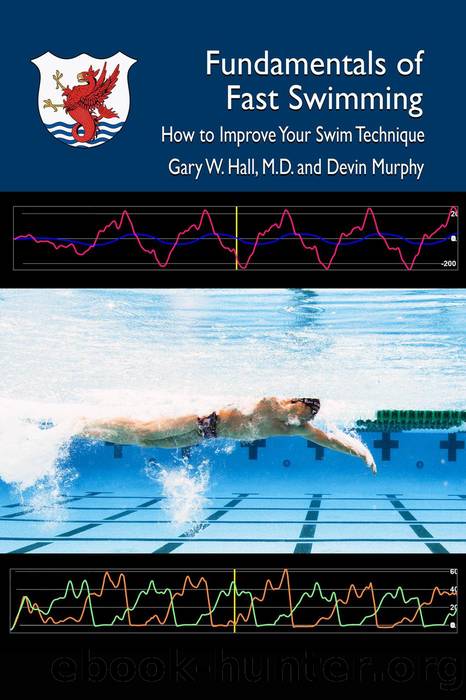Fundamentals of Fast Swimming: How to Improve Your Swim Technique by Gary Hall

Author:Gary Hall [Hall, Gary]
Language: eng
Format: epub
Amazon: B08JJHDY84
Publisher: The Race Club, Inc.
Published: 2020-10-14T19:00:00+00:00
Olympian Mike Alexandrov initiates the lift phase with a 45-degree pitch of the hand and fingers separated (VM technology).
Propulsion Phase
The propulsion phase in the breaststroke pull does not last long, approximately .15-.20 seconds, but it provides virtually all of the propulsion from the arm pull. It starts with the bending of the elbows toward the end of the outsweep and a change in direction and position of the hand from a horizontal side motion to a vertical, quick backward motion. The hands drop deeper in the water and the fingers point down and press backward. The hands should not move backward very far nor for very long. Since the forearm and hand release and recover mostly under the water, moving the hands too far backward results in too much frontal drag on their way forward.
With the loop pull technique, as the hands turn the corner, drop deeper in the water and start moving backward, they should be positioned well outside the elbows. Before the hands reach the level of the shoulders (from side view) as they are moving backward, they turn inward and start moving toward each other. This is referred to as the insweep. At that time, the elbows begin to drop down and press backward quickly toward the chest, generating a small amount of propulsion in the process from the upper arms. Once the insweep begins and the hands, pitched to about 45 degrees, move toward each other, the propulsion is over.
For two reasons the propulsion and resultant increase in body speed generated by the arms is short-lived. First, as the arms near the out sweep and prepare for the propulsion phase, the shoulders, head and upper body begin to elevate out of the water, putting the body into a very bad drag coefficient position. Second, immediately after the pull propulsion, the legs begin to draw forward in preparation for the kick, putting the body into an even worse drag position. With both of those movements happening, the swimmerâs velocity drops to nearly zero, even with the Olympians.
The elevation of the shoulders high above the water is for a good reason, however. The propulsion of the pulling hands is augmented by the elevation of the shoulders, head and upper body during this phase, an important coupling motion. The faster and higher the swimmer elevates the shoulders, the more positive impact that upper body motion has on the propulsion of the hands, similar to rowing a boat. It is always better in rowing to use the back muscles along with the arms.
Download
This site does not store any files on its server. We only index and link to content provided by other sites. Please contact the content providers to delete copyright contents if any and email us, we'll remove relevant links or contents immediately.
The River by Peter Heller(2258)
Breath by James Nestor;(2231)
Sea Survival Handbook by Keith Colwell(2199)
Fatal Storm by Rob Mundle(2172)
Deep by James Nestor(2141)
Lonely Planet Australia by Lonely Planet(2034)
Iced In by Chris Turney(1959)
Discover Australia by Lonely Planet(1906)
Lonely Planet Maldives (Travel Guide) by Planet Lonely & Masters Tom(1800)
One Girl One Dream by Dekker Laura(1639)
Looking for a Ship by John McPhee(1630)
Chicken Soup for the Ocean Lover's Soul by Jack Canfield(1603)
Ten Degrees of Reckoning: The True Story of a Family's Love and the Will to Survive by Hester Rumberg(1601)
Lonely Planet Australia (Travel Guide) by Lonely Planet & Lonely Planet(1552)
South with the Sun by Lynne Cox(1542)
The Wave In Pursuit of the Rogues, Freaks and Giants of the Ocean(1505)
Diver Down by Michael Ange(1471)
Marlinspike Sailor's Arts and Crafts by Barbara Merry(1455)
The Golden Rules: 10 Steps to World-Class Excellence in Your Life and Work by Bob Bowman & Charles Butler(1429)
